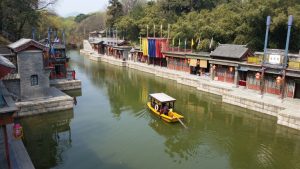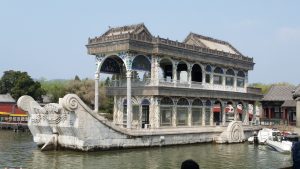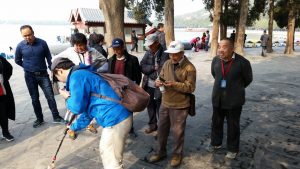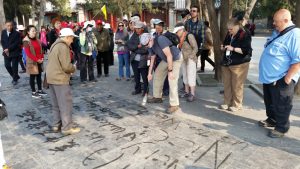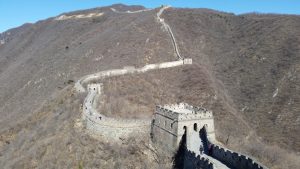 Early on during our tour of China we made our obligatory foray to the Great Wall. We had arranged to stay in a guesthouse at a section of the wall further out from Beijing and, therefore, less crowded. The strategy worked perfectly and we found ourselves hiking great stretches of the wall while passing only the occasional other tourists and no tour groups. The weather was fair and we had a splendid morning. I’ve previously written about the GW so won’t comment further here. I’ll let the photos do the talking for me.
Early on during our tour of China we made our obligatory foray to the Great Wall. We had arranged to stay in a guesthouse at a section of the wall further out from Beijing and, therefore, less crowded. The strategy worked perfectly and we found ourselves hiking great stretches of the wall while passing only the occasional other tourists and no tour groups. The weather was fair and we had a splendid morning. I’ve previously written about the GW so won’t comment further here. I’ll let the photos do the talking for me.
 As is often the case on a tour, an intermediate stop added to “fill a tour day” turned out to be a real bonus. On our way out of Beijing en route to the GW, we stopped at the Summer Palace. I’d expected more Forbidden City type architecture and had a slight fear of repetition. But the SP turned out to be a a pleasant surprise.
As is often the case on a tour, an intermediate stop added to “fill a tour day” turned out to be a real bonus. On our way out of Beijing en route to the GW, we stopped at the Summer Palace. I’d expected more Forbidden City type architecture and had a slight fear of repetition. But the SP turned out to be a a pleasant surprise.  The lake-side setting is lovely and residence buildings dot the shoreline, connected by covered walkways and rows of blossoming trees. Courtyard walls sport differently shaped windows, each tastefully painted with a creative image. Pagodas can be seen on the hillside above, arched bridges and willow trees ad to the Chinese painting feeling, and a Suzhou fishing village and shopping street was recreated on the grounds.
The lake-side setting is lovely and residence buildings dot the shoreline, connected by covered walkways and rows of blossoming trees. Courtyard walls sport differently shaped windows, each tastefully painted with a creative image. Pagodas can be seen on the hillside above, arched bridges and willow trees ad to the Chinese painting feeling, and a Suzhou fishing village and shopping street was recreated on the grounds.
The SP was and is infamous as the primary residence of the Dowager Empress Cixi, aka the Dragon Empress, who enlarged and embellished the complex. She was a 19th C ruler who wielded tremendous power and intimidation. For example, her advisors tried to warn her of her excesses with an allegory of a boat which depends on the river and must be careful the river doesn’t rise up and overturn it. Her response: she built a marble boat in the lake to represent her stability and imperviousness to challenge.
As pleasant as the SP was, the best moment of the visit was a spontaneous cultural connection moment. Apparently, retirees from the area like to come to the SP park to engage visitors. A few have rigged giant calligraphy brushes out of a broomstick, ½ liter water bottle, and a sponge tip. They write large-scale calligraphy on the pavement, in water.
Then it magically evaporates like disappearing ink. One fellow in particular engaged our group. He was overtly friendly and invited us to have a try with his giant water pen. He wrote messages of welcome, hopes for peace and understanding in the world, and friendship toward America. It was a perfect cultural exchange of good will. Two weeks later, on the last night of the tour, several of our group mentioned the experience as one of their tour highlights. This is why we travel.

